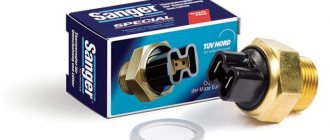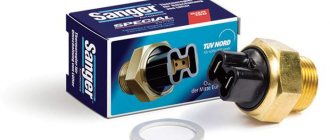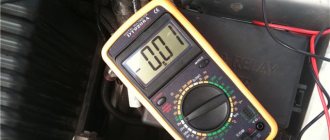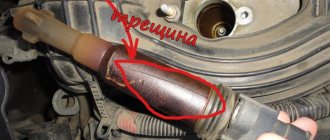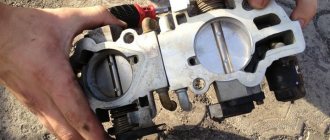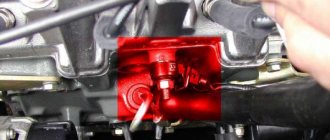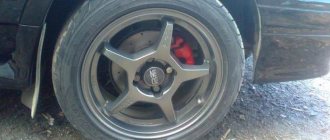02/04/2022 7,069 VAZ 2110
Author: Ivan Baranov
By measuring compression in cylinders, you can diagnose the parts of the power unit without disassembling it. For correct diagnosis, you need to know what compression should be in the VAZ 2110 engine. The article contains information on methods for measuring compression and detailed instructions with a video test of a 16-valve engine.
[Hide]
Compression - what is it and what should it be?
Compression is a measure of the maximum pressure in the combustion chamber that the piston can create when it reaches TDC during the compression stroke.
Measuring this indicator gives an idea of the tightness of the chamber, which in turn depends on the condition of a number of elements - the piston and compression rings, valves with seats, head gasket, and the installed thermal gap in the timing belt.
Since the compression measurement technology itself is simple, and the data obtained as a result of its implementation makes it possible to estimate the remaining life of the power plant and identify a number of malfunctions, this diagnostic operation is quite common.
Although car power plants have a common design principle, they are structurally different, which also affects compression indicators.
Each engine has its own specific maximum pressure values in the combustion chambers, which must be indicated in the technical specifications. documentation for the car.
For example, for a VAZ-2106 a compression of 11 kgf/cm2 is considered normal, but for a VAZ-2110 this figure is already 13 kgf/cm2.
Note that when measuring, it is not necessary that the device should show values that correspond to the norm. As engine components wear, compression readings will drop.
Moreover, if they drop below a certain value, this will be a signal of extreme wear of the power plant’s CPG, and the need for major repairs.
Some variation in readings between cylinders is also allowed. However, it should not exceed 1 kgf/cm. sq.
That is, if measurements on a VAZ-2115 showed that the compression in the cylinders was 12 kgf in the 1st, 11 kgf in the 2nd, 12 kgf in the 3rd, 12 kgf in the 4th, then the power plant of the car will be considered to be in working order.
Read more about compression and compression ratio of a diesel engine.
What to do if you don’t have a compression gauge at hand?
Is it possible to measure compression without a device? Practice shows that yes, it is possible. But this method will give relative and approximate readings. To measure the compression indicator without instruments, remove the spark plugs from all cylinders except the one being tested. Manually rotate the crankshaft until the compression stroke ends (watch the marks - they should match). Perform this operation on all cylinders one by one. Where the pressure is low, it will take less effort to turn the crankshaft. In this way, of course, you will not get accurate compression readings in the engine. But it is possible to understand the presence of problems.
It is recommended to measure compression every 20-30 thousand kilometers, so every car enthusiast is recommended to have his own compression gauge. Its price is not so high that it is worth saving on it.
Reasons for a drop in compression in one cylinder
It also happens that a pressure drop occurs in one of the cylinders, and significantly (in some cases, compression can drop to 3-4 kgf/cm2).
And such diagnostic results are a reason to worry, because there are malfunctions in the power plant.
The reasons for a drop in compression in one of the cylinders above normal may be:
- COMPRESSION RINGS. These elements play one of the most important roles, since their task is to ensure tightness in the piston-cylinder pair. If the rings are damaged (burst) or stuck, they will begin to leak working gases into the sub-piston space, which is why a significant drop in compression occurs;
- VALVES. Through these elements, the components of the combustible mixture are admitted and exhaust gases are removed. But during the compression stroke, the valves are closed, which seals the combustion chamber. But if, due to a violation of the combustion processes, the edge of the valve plate and seat are burnt, or the thermal gap is broken, and it turns out to be slightly pressed, then the tightness of the chamber is not maintained, which affects the compression;
- PISTON. This element is rarely to blame for a drop in pressure in the cylinder, but there are still situations when the reason lies precisely in it. As a result of the same process changes, the piston crown may burn out. This usually happens due to a violation of the ignition angle. And if the piston burns out, then there will be no tightness;
- BLOCK HEAD. Although rare, it does happen that cracks and other defects appear in the combustion chamber, affecting the loss of compression. Also, the head can cause a loss of pressure in some cylinder if it fails due to overheating. Due to changes in geometry, the head in some places simply does not fit tightly to the gasket. Even a simple insufficient tightening of the cylinder head bolts can affect compression;
- cylinder head gasket. Due to internal defects or overheating, a breakdown of this gasket may occur. As a result, one of the cylinders is connected to a channel of the cooling or lubrication system, another cylinder (in this case, a strong drop in compression is observed in two cylinders), and the breakdown can also lead out of the engine. Read more about the signs of a broken cylinder head lining.
Also read why the car engine does not pull.
What and how to measure compression?
As noted above, measuring compression is a simple operation, and it can easily be performed in a garage.
But for this you need a special measuring device - a compression meter.
In fact, this is a regular pressure gauge, equipped with a check valve, as well as an extension cord for ease of diagnostics (the kit may also include attachments for working with different power plants).
In addition to this, the device will also require a spark plug wrench. You won’t be able to diagnose it yourself, so you also need an assistant.
Let's look at how compression measurements are made using the example of a VAZ Kalina car.
The sequence of actions for diagnostics is as follows:
- Warm up the engine to operating temperature;
- We relieve the pressure in the fuel rail (pull out the fuel pump fuse, and then start the engine again so that it produces the remaining gasoline in the rail);
- We remove the tips of the spark plugs, as well as from the ignition module;
- We unscrew all the spark plugs;
- We install a compression gauge in the spark plug hole of the cylinder;
- We ask the assistant to press the gas pedal all the way (this will ensure maximum air supply to the cylinder, which will make the readings more accurate), and then turn on the starter. In this case, to obtain correct data, it is necessary that all 4 strokes have passed in the cylinder being measured, that is, you need to turn the crankshaft at least 2 turns;
- Since the compression meter has a check valve, the device will record the maximum pressure value in the cylinder;
- We write down or remember the obtained pressure value, reset the readings and move on to the next cylinder.
After taking measurements in all cylinders, we compare the data. If the difference in readings does not exceed 1 kgf/cm2, put the spark plugs in place and continue operating the car.
Engine Lada Vesta
Products from the assortment of Dustershop77 on the topic of the article: Image
| vendor code | Name | Manufacturer | Price | Availability | Add to cart |
| DC1300-20182 | Throttle valve gasket kit K4M/F4R (large+small) ROSTECO | Analogue | 500 / 350 rub. Discount: 250 rub. | 2 | |
| DC380-ASAM-30376 | Radiator mounting pad ASAM-SA 30376 analog art. 7700430992 / 215081131R | Analogue | 150 / 100 rub. Discount: 80 rub. | 5 | |
| DC800-8200291355 | Crankcase gas recirculation valve Renault 8200291355 | Original | 4500 / 3900 rub. Discount: 3200 rub. | 3 | |
| DC919-226A41772R | Oxygen sensor lambda probe upper Duster, Vesta and other engines. H4M 1.6 226A41772R / 226901841R / 226906393R | Original | 4500 / 4200 rub. Discount: 3900 rub. | 5 | |
| DC1211-8200132254 | Fuel injector for K4M engine original 8200132254 | Original | 2200 / 1900 rub. Discount: 1600 rub. | 8 | |
| DC1321-161757436R | Throttle valve gasket H4M original 161757436R | Original | 800 / 600 rub. Discount: 500 rub. | 1 | |
| DC619-8200048024 | Expansion tank cover original Renault 8200048024 | Original | 700 / 500 rub. Discount: 250 rub. | 1 | |
| DC981-FCR210114 | Electric fuel pump FRANCECAR FCR210114 | Analogue | 1500 / 1200 rub. Discount: 1100 rub. | 2 | |
| DC1398-30777 | Gasket for fuel pump ring ASAM 30777 | ASAM | 300 / 200 rub. Discount: 150 rub. | 3 | |
| DC1200-BK64105/30598 | Fuel pump ring with gasket | Analogue | 1000 / 700 rub. Discount: 500 rub. | 3 | |
| DC1322-224332428R | Ignition coil 1.6 H4m original 224332428R | Original | 2900 / 2500 rub. Discount: 2100 rub. | 2 | |
| LRT-002/6001548140 | Washer reservoir is not original, ANALOGUE 6001548140 | LOGEM | 1000 / 900 rub. Discount: 500 rub. | 1 | |
| DC382-ASAM-30494 | Expansion tank ASAM-SA 30494 (7701470460) | Analogue | 1000 / 700 rub. Discount: 600 rub. | 1 | |
| DC1314-135101KT0A | Front crankshaft oil seal H4M original 135101KT0A | Original | 900 / 700 rub. Discount: 550 rub. | 2 | |
| DC1320-161191KA1B | Throttle valve H4M original 161191KA1B | Original | 25000 / 18900 rub. Discount: 17900 rub. | 1 | |
| DC1746 | Membrane of the crankcase gas recirculation valve Renault Duster, Captur, Terrano, etc. (KVKG membrane F4R 2.0) | Analogue | 2200 / 1700 rub. Discount: 1500 rub. | 2 | |
| DC1766 | Throttle valve gasket repair kit K4M/F4R (large+small) Balakovo PTP64 | Analogue | 300 / 200 rub. Discount: 150 rub. | 2 | |
| 6001548140 | Washer reservoir Renault 6001548140 original | Original | 2000 / 1700 rub. Discount: 1500 rub. | 1 | |
| DC918-226A44171R | Oxygen sensor lower lambda probe H4M 1.6 Lambda probe Renault 226A44171R | Original | 11000 / 10500 rub. Discount: 9900 rub. | 1 | |
| DC955-150100565R | Oil pump for F4R original 150100565R | Original | 5500 / 4800 rub. Discount: 4400 rub. | 1 | |
| DC957-8200665520 | Starter K4M 1.6 original 8200665520 | Original | 12000 / 9900 rub. Discount: 9500 rub. | 1 | |
| DC1302-166008992R | Fuel injector for H4M engine original 166008992R | Original | 3500 / 2600 rub. Discount: 2400 rub. | 4 | |
| DC1315-122791HC0A | Rear crankshaft oil seal H4M original 122791HC0A | Original | 2000 / 1700 rub. Discount: 1400 rub. | 1 | |
| DC1663-21120370501015 | Ignition coil VAZ 1.6/1.8 21129/21179 original 21120370501015 | Original | 1900 / 1200 rub. Discount: 900 rub. | 4 | |
| DC1664-21179113201000 | Fuel injector VAZ 1.8l 2179 original 21179113201000 | Original | 1800 / 1500 rub. Discount: 1300 rub. | 4 | |
| DC1643-140323253R | Intake manifold gasket H4M original 140323253R | Original | 1900 / 1500 rub. Discount: 1400 rub. | 1 | |
| DC1644-140328698R | Intake manifold gasket H4M original 140328698R | Original | 700 / 600 rub. Discount: 400 rub. | 4 | |
| DC1738 | Fuel pump fuel filter mesh Renault Duster, Captur, Terrano, Vesta, etc. 2.0 / 1.6 (Masuma) | Analogue | 800 / 500 rub. Discount: 350 rub. | 1 | |
| DC522-233009370R | Starter for F4R engine original art. 233009370R | Original | 14000 / 10600 rub. Discount: 9900 rub. | ||
| DC1682-6001549070 | Fuel vapor absorber original 6001549070 | Original | 3300 / 2500 rub. Discount: 2000 rub. | ||
| DC1740 | Fuel filter for submersible fuel pump Renault Duster, Captur, Terrano, Vesta, etc. 2.0 / 1.6 (LYNX) | Analogue | 2100 / 1800 rub. Discount: 1400 rub. | ||
| DC1002-B208A03276 | Fuel injector for K4M DEKO engine B208A03276 (analogue 8200132254) | Analogue | 2000 / 1500 rub. Discount: 1300 rub. |
How to determine why the compression in the cylinder has dropped?
If it is determined that in one of the cylinders the compression is below normal, it is necessary to determine what exactly caused the problem.
To more accurately determine why the pressure in the cylinder dropped, you should carry out several simple procedures:
- Pour 10-15 g into the cylinder with reduced compression. engine oil, then measure again. If the indicators have improved, it means that the reason for the fall lies in the rings (they are stuck or one of them has burst);
- Remove the valve cover and check the valve clearances on the required cylinder;
- Carefully inspect the engine at the junction of the head and the block. If there is a gasket breakdown leading outward, oil leaks will be visible;
- Pull out the dipstick and assess the condition of the oil. If it is very blackened and a burning smell is clearly visible, then this may indicate a breakdown of the gasket, in which the cylinder is connected to the oil channel;
- Assemble the engine and start it. Then you should inspect the expansion tank of the cooling system. If escaping air bubbles are visible in it, this will signal the connection of the cylinder with the channel of the cooling system. Additionally, you can put your hand on the exhaust pipe while the engine is running. If small sweet-tasting drops remain on the palm, this will indicate that coolant has entered the cylinder, that is, there is a breakdown.
If all the procedures carried out did not produce results, that is, after filling the oil, the compression did not increase, the thermal clearances are normal and there are no prerequisites for a breakdown of the cylinder head gasket, then the reason lies in the piston, valves or cylinder head.
But to make sure of this, you will have to remove the block head.
Abnormal indicators
As you probably could have guessed, this is when in one of the four cylinders the pressure is significantly different from the others, for example in one it is 5.0, and in the others it is 9.5 atm. YES and the engine will not work stably. There are abnormal indicators in two and even three or four “pots”. But this already means that your engine is almost dead and needs to be overhauled!
So why does this happen - when in one the pressure is much less than in the others? There may be several reasons for this, all from my experience, but you almost always need to remove the cylinder head:
1) The gasket is broken. This happens very often when the gasket between the block and the block head breaks - we just replace it.
2) The head is not tightened. This is a continuation of the first reason - if the head is not tightened correctly, the gasket can also leak pressure.
These are the simplest reasons, but they are the most common - for example, this often happened on my new purchased VAZs, in particular on a VAZ 2114 and a friend on a VAZ 2110. So, first of all, we go there, on new "our brands" - the problem This will be 80%. Then there are more complicated problems.
1) O-rings are leaking. This happens due to wear and tear, or because they are broken. However, if the pressure has dropped in one of the cylinders, then it is most likely broken. The repair is complicated, you need to disassemble the block itself to remove the pistons.
2) The rings are coked. I decided to put it in a separate section - low-quality motor oil can cause the rings to become coked.
The oil simply burns at the points of contact and seals the rings in one place - although this is not correct, the rings do not move along their grooves, and only one side is machined, which leads to rapid wear - although in this way the pressure will drop in all 4 cylinders. Because oil lubricates all 4 pieces.
3) Wear of the block wall. This is rare - but it does happen, that is, the ring has nothing to do with it, but it is the walls that they rub against that suffer. Most likely, this is low-quality material.
4) Engine overheating. When overheated, the tightness of the rings and walls of the block is lost, they begin to leak both pressure and engine oil. An indirect sign is blue smoke from the exhaust pipe during operation.
5) Burnt out - the piston itself broke. In such cases, compression may simply drop to “zero”.
Sometimes the piston itself burns out, it can be a small “burnout” on the side, or a very large one – for example, in the middle. It also happens that the piston breaks, for example from meeting a valve when the timing belt breaks - again we lose atmosphere.
6) Valves. There are many reasons for this. This is also an incorrect adjustment. And it happens that a valve burns out - only one burns, so the compression will vary in exactly one cylinder. It can also break if the timing belt breaks.
These are the main reasons why the values will differ in exactly one pot out of all four.
Debugg
Eliminating the causes of a drop in compression in one of the cylinders directly depends on what was to blame for its occurrence.
Most often, this problem occurs due to the occurrence of rings. The formation of carbon deposits (coking) in one of the cylinders occurs due to the penetration of a large amount of oil into it.
For example, this can happen if the valve stem seals for that cylinder are damaged.
The difficulty of repairing compression loss caused by rings depends on the nature of the damage.
If they just lay there, then you can try to decarbonize them. But if the rings burst, then you will have to disassemble almost the entire engine to replace the damaged elements.
The same applies to valves. If they are misadjusted, it is enough to bring the thermal gaps back to normal. But if the valves and their seats are burnt, then repair work is carried out on the cylinder head - the valves are changed and they are ground in.
Regarding the cylinder head gasket, if it’s all because of it, then they change it. But with the block head, not everything is so simple.
If it was caused by overheating, then you can still fix the problem by trimming the surface.
But if defects form in the body of the head, it is replaced. Any piston malfunction is definitely a replacement.
Why check
It is recommended to check the compression on the VAZ 2110 regularly to prevent possible malfunctions and problems with the engine.
Measurements are taken with the throttle valve open and closed. Each test option gives its own results and data on the condition of the engine.
Checking with the valve open allows you to determine:
- Problems and damage on cylinder surfaces;
- Deformation, burnout of valves;
- Sticking or coking of piston rings.
If you check the compression with the throttle closed, you can find out:
- Are the valves stuck?
- Is there a tight fit to the valve seat?
- If a hydraulic tappet is present, the presence of defects in the camshaft cam profile is determined.
Methods
There are two main ways in which you can check the compression readings in the engine.
Peculiarities
Using measuring instruments
Effective, gives the most accurate results. But it requires special measuring instruments - a pressure gauge or compression gauge. Applicable in 90% of cases
Difficult to perform because it requires unscrewing the spark plug from each cylinder and cranking the crankshaft. A problematic cylinder can be determined by the effort that has to be applied when turning. Efficiency is not high
Considering the possible results of the test, it is recommended to always check the compression only with measuring instruments and do this at least once every 3-4 months, as well as if there is a suspicion of unstable engine operation.
We take measurements


